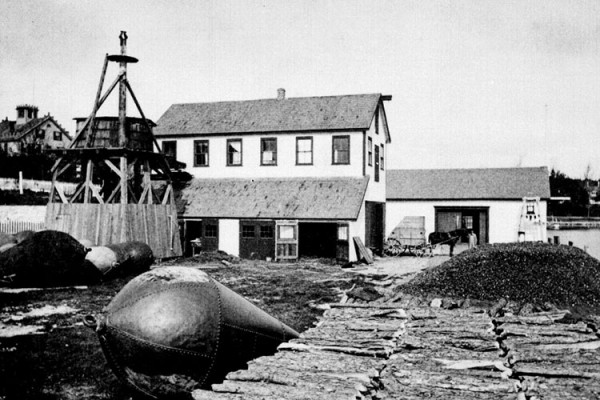
The original laboratory of the U.S. Fish Commission, a renovated U.S. Lighthouse Board maintenance shed on Little Harbor in Woods Hole, Massachusetts. Image taken around 1881
We are celebrating our 30th birthday, so we thought it a good time to recognize the anniversary of an organization also dedicated to improving the fisheries through science. First called the Fish Commission, they are quite a bit older than us: NOAA Fisheries. The governmental organization and parent of the Northeast Fisheries Science Center got its start 150 years ago, fittingly enough on fishy Cape Cod. Read more in this reporting from @NOAAFisheries, which in this form is an amalgam of two historic pieces:
On February 9, 1871, President Ulysses S. Grant signed the law that created the Fish Commission. It was the nation’s first federal conservation and environmental research agency and began in a shed in Woods Hole.
The agency was devoted to the protection, study, management, and restoration of fish. Massachusetts, Rhode Island, and Connecticut were trying to address a serious decline in marine fish catches. However, there was not a consistent approach or common understanding of the decline.
Congress got involved to provide federal support and authorized the Fish Commission. It was charged with conducting an official inquiry into the decline in fishery catches off Southern New England. For the most part this centered on commercial harvest operations using fish pounds and weirs, and subsistence fishermen and anglers using handlines. If there was indeed a decline, the commission was to study its causes and recommend ways to reverse it.
President Grant appointed prominent scientist Spencer Fullerton Baird to lead the commission. Baird, an eminent zoologist and the first assistant secretary of the Smithsonian Institution, laid much of the groundwork himself, using his many contacts in Congress. He more or less volunteered to take on the task.
He hit the ground running in his second, and unpaid, government job as Fish Commissioner. Within a few months, he established the first U.S. marine research station at Woods Hole, chosen for its central location, support facilities, clean water, and good access to offshore fishing sites. The agency now known as NOAA Fisheries grew from there.
The shed was renovated and expanded in 1875, with federal and private funds, into a more permanent, two-story laboratory with a windmill for pumping seawater for the research aquaria.
The first floor was focused on research on fish, the second for biologists studying invertebrates. A small part of the shed, unofficially known as the “Sharks Parlor,” was set aside for conversations, reading, and relaxation.
Most research was conducted during the summer months, when students and university researchers would join the Fish Commission staff. Collecting species in local waters and studying them was a priority since many were unknown. Year-round operations continued on a much smaller scale under local resident Vinal Nye Edwards. Edwards was a naturalist and collector and the first federal fisheries employee.
As the scope of research activities and staff grew, a larger and more permanent facility was needed. Construction on the lab commenced in 1884, beginning with a seawall and refuge for small vessels. The 120×40-foot laboratory building and other support facilities were completed in 1885.
Baird had been handed a tall order, as marine fisheries science was in its infancy. Also, there was as yet little in the way of systematic data collection about marine fisheries and fish. He needed to gather information not only on fish numbers, but also on the general natural history of the waters supporting these fish, and on the businesses that depended on them.
Working with a few others, Baird devised a wide-ranging research plan. It would be familiar to any fishery scientist today:
- Identify the fish and fisheries to investigate
- Quantify fish declines
- Investigate possible causes for declines
- Determine what these fish ate, and any changes in prey availability
- Look for evidence of distribution changes
- Search for indications of disease
- Check records for temperature anomalies or extremes
- Evaluate predation on the fishery species that were the focus of the investigation
- Estimate the “agency of man,” influences that he defined as pollution, overfishing, and destructive fishing methods
After two exhaustive field seasons, Baird hit on two possible causes for the perceived decline: predation by bluefish on the fish in question, and intensive fishing for too long and at the time of year when fish were spawning. Since there was little to be done about bluefish that didn’t involve killing off one food fish to save others, the commission proposed a simple remedy. They settled on “occasional intermission during the six weeks when most of these fish deposit their eggs, of sufficient length of time to allow a certain percentage to pass through to their breeding ground.”
Baird then started on what would be his final scientific quest: Establishing permanent federal capability to understand the nation’s marine resources. Upon his death in 1887, Congress reorganized the commission into a permanent government agency. It had a paid, full-time commissioner and a renewed focus on a broad array of basic and applied research in marine and environmental sciences.
